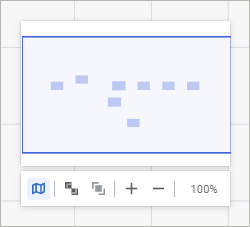 Short/Detailed Form button on the toolbar.
Short/Detailed Form button on the toolbar.A working area is a container where ETL task objects are located. A working area is a convenient method of:
Visual arranging task objects on the same working area.
Providing access to task object properties.
Showing links and dependencies between objects.
Main objects in the working area can be displayed in the short or detailed form. When the short form is selected, only object icons are displayed. When the detailed form is selected, an object icon, name and type are displayed. To change the view, use the  Short/Detailed Form button on the toolbar.
Short/Detailed Form button on the toolbar.
To hide or show the parameters panel, click the  Parameters button on the toolbar.
Parameters button on the toolbar.
To move in the working area, execute one of the operations:
Select the  Hand mode on the toolbar and hold down the mouse button. If the
Hand mode on the toolbar and hold down the mouse button. If the  CUrsor mode is selected, use the drop-down list to change the mode and select objects.
CUrsor mode is selected, use the drop-down list to change the mode and select objects.
Hold down the SPACE key and the mouse button.
Use keyboard arrow keys.
Scroll the mouse wheel to move the working area vertically. Scroll the mouse wheel while holding down the SHIFT key to move the working area horizontally.
Use the minimap. To show minimap, click the  Enable Minimap button on the working area display settings panel:
Enable Minimap button on the working area display settings panel:

To zoom the working area:
Scroll the mouse wheel while holding down the CTRL key.
Use the working area display settings panel:

The following operations are available on the panel:
 Fit to All Objects. Change working area zoom to fit all objects.
Fit to All Objects. Change working area zoom to fit all objects.
 Fit to Object. Change working area zoom by the selected object.
Fit to Object. Change working area zoom by the selected object.
NOTE. If no working area object is selected, the  Fit to Object button is disabled.
Fit to Object button is disabled.
 Zoom In. Increase working area zoom by 25%.
Zoom In. Increase working area zoom by 25%.
 Zoom Out. Decrease working area zoom by 25%.
Zoom Out. Decrease working area zoom by 25%.
The working area can be zoomed within the range [1%, 400%]. To set 100% zoom, click the button displaying the current zoom.
See also: